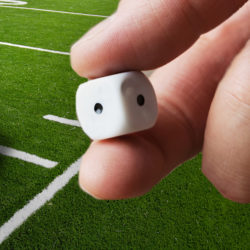
If you’ve ever played fantasy sports, chances are that most of the drafts you have done have been a snake format. Anyone who has felt the frustration of an unfavorable draft position knows that, with a snake draft, you often won’t have a shot at some of your favorite players. An auction draft can be a fun alternative that lets you have whatever player you want, as long as you stay within your fixed bankroll. Auction drafts can be intimidating if you’ve never done one before, so here are some tips that can help you avoid some common traps and approach auctions using some ways we think about things at SIG.
When bidding for any product, whether it’s a financial asset or a player in a fantasy draft, it’s important to come up with what you think is the “fair value” and look to buy assets that are trading “cheap.” Player projections on your favorite fantasy website can be a good starting point for auction fair values, but those projections aren’t perfect. What if a player just suffered a hamstring injury in practice or there is a lot of uncertainty about which running back will get the most touches on a particular team? Fantasy rankings don’t always reflect the latest news and there can be a great deal of disagreement between different websites. To come up with the best auction values, you will have to make your own adjustments to the statistical projections you find online.
Let’s say that your projections for a particular player are much higher than the fantasy experts’ online projections. Does this mean that you should try to draft him in every league, name your team after him, and immediately buy his jersey with your expected future fantasy winnings? Not so fast. It’s important to realize that over the long term, a market with as much transparency as fantasy sports is efficient. Everyone has access to the same player statistics, the same news, and the same fantasy expert opinions. So, if there is a large discrepancy in values, you should always revisit your assumptions (Why doesn’t the world love this player as much as I do?), seek out disconfirming evidence (How could this player become a bust?), and then adjust if necessary. If you still feel like he should be worth more than the fantasy world thinks, then go get him!
This is what makes auctions so much fun; no two people in an auction will have the same values for each player, so you’ll see some players bought at levels that seem way too high and other players that seem like a steal. How do you decide on which bargains to go for? Should you just bid on every player as long as the price is below your fair value? While this will allow you to buy players that are auctioned at “cheap” prices, it won’t maximize how you use your fixed bankroll. For example, bidding for Aaron Rodgers when he’s $1 below your fair value could prevent you from buying Tom Brady later when he is $5 cheap. On the other hand, if you wait around for the perfect bargain, you might end up with too much money at the end and have to pay up for mediocre players.
Maximizing decisions come up every day in trading and if you don’t spend time thinking about how to maximize, you’re leaving money on the table. In fantasy sports, coming up with good fair values and maximizing using those values could be the difference between bragging rights and “better luck next year.”




Subscribe Now
Get each new post sent straight to your inbox